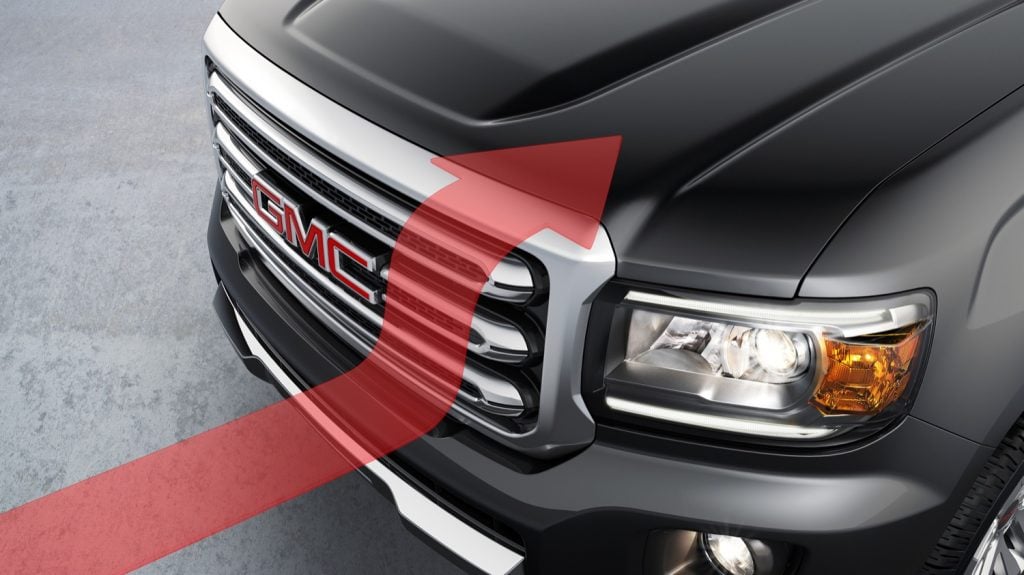Active Aero Shutters are a General Motors active aerodynamics technology that improve the aerodynamic performance and maximize aerodynamic efficiency of a vehicle in order to deliver better fuel economy.
How It Works
Electronically-controlled Active Aero Shutters are positioned in a vehicle’s front fascia, either at the vehicle’s lower grille opening (forming the lower aero shutters), the upper grille opening (forming the upper aero shutters), or the upper and lower grille openings (forming the upper and lower aero shutters). The vehicle’s computer system determines when to open or close them based on various conditions.
GM says that the onboard computer system that controls the active air shutters is programmed to keep them closed as often as possible to reduce aerodynamic drag.
The position of the shutters is based on a multitude of factors, but the basic premise behind their operation is as follows:
- Shutters open in instances when cooling airflow to the engine is needed, like when towing, climbing a steep grade, or in other situations that powertrain temperatures rise above certain threshold conditions.
- Shutters close on the highway when engine cooling needs are reduced, thereby reducing aerodynamic drag and maximizing aerodynamic efficiency by pushing more air around the vehicle.
Many active grille shutter systems are programmed to change position based on the vehicle’s traveling speeds, but GM’s aerodynamic shutters have a proprietary algorithm that monitors several variables in real time – including engine load, vehicle speeds and ambient temperature – to determine if the shutters should be opened or closed.
There’s also an “ice mode” that activates when ambient temperatures fall below freezing. By working in conjunction with onboard sensors and a thermometer that monitors outside air temperature, ice mode prevents movement of the aero shutters until ambient temperatures rise above the freezing mark or until powertrain temperature has reached a healthy operating temperature.
Vehicle Applications
Active aero shutters are occasionally assigned RPO code VTI. They are present on the following models, either as lower only, upper only, or both in the upper and lower grilles:
Chevrolet
- 2014 – 2016 Spark EV
- 2010 – 2015 Cruze Eco
- 2016 – present Volt
- 2011 – 2015 Malibu
- 2014 – present Impala
- 2018 – present Equinox
- 2019 – present Blazer
- 2018 – present Traverse
- 2015 – present Tahoe
- 2015 – present Suburban
- 2015 – present Colorado
- 2017 – present Silverado 1500
- 2020 – present Silverado 2500HD (expected)
- 2020 – present Silverado 3500HD (expected)
Cadillac
- 2013 – 2019 ATS
- 2014 – 2019 CTS
- 2016 – present CT6
- 2017 – present XT5
- 2015 – present Escalade
Buick
- 2012 – present LaCrosse
- 2016 – present Envision
- 2018 – present Enclave
GMC
- 2018 – present Terrain
- 2017 – present Acadia
- 2015 – present Yukon
- 2015 – present Yukon XL
- 2015 – present Canyon
- 2017 – present Sierra 1500
- 2020 – present Sierra 2500HD (expected)
- 2020 – present Sierra 3500HD (expected)
Generations
Active aero shutters were initially introduced only on a vehicle’s lower grille. Shortly thereafter, their use was expanded for both the lower and upper grilles.
Other Names
Active aero shutters are also referred to as:
- Active air shutters
- Active aero louvres
- Active air louvres
- Electronically-controlled air shutters
- Electronically-controlled aero shutters










